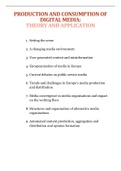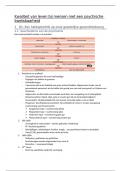PRODUCTION AND CONSUMPTION OF
DIGITAL MEDIA:
THEORY AND APPLICATION
1. Setting the scene
2. A changing media environment
3. User-generated content and misinformation
4. Europeanization of media in Europe
5. Current debates on public service media
6. Trends and challenges in Europe’s media production
and distribution
7. Media convergence in media organisations and impact
on the working floor
8. Structures and organization of alternative media
organisations
9. Automated content production, aggregation and
distribution and opinion formation
,PRODUCTION AND CONSUMPTION OF
DIGITAL MEDIA: THEORY AND
APPLICATION
Les 1, 28/09
INTRODUCTION
Relevance of Digital Media
Grafieken over sociale media:
Internet use is above 75 % in most EU countries, in
Belgium more and people report very high daily internet
use
Smartphone penetration is increasing each year
Social networking sites use has increased, YT en FB are on
the top
People are moving more to private networks = a shift
2/3 use one or more apps for news
A different pattern in different parts of the world
Telegram usage for news is increasing and has even dubbled in
some countries
In Belgium: Facebook is on the top, then Yt
Sharp increase of smartphone ownerships → being constantly
connected and being online + changed news use
o More accessing news through mainly rather smartphone e.g. video, podcast news
o Question for students: Which of these was the *MAIN* way in which you came across news
online in the last week? Mostly social media (65), a few direct via websites or apps of news
media (21).
Across all countries ¼ prefers to access news through a website or app, this has decreased
People under 35 yo, there is an even weaker connection with websites and apps, most people access
news through social media. Social media are a main gateway for young newsconsumers
Some questions part of this lectures:
To what extent does digital/social media have an impact on the long term strategic focus for
traditional media houses?
Are traditional media houses playing a role in diminishing their value and creating an audience shift
phenomenon?
What will traditional media houses’ future unique selling point be?
How to best monetize content produced by traditional media houses and distributed online?
,CHARACTERISTICS OF MEDIA MARKETS
The Value Chain
News media are two-dimensional enterprises: guided by journalistic norms and ethics, but also
business models, market norms, and value (profit driven) (Underwood, 1995)
Media companies form mutual sequences of essential links
Each link comprises a specific activity and adds value as such
The (vertical) value chain is the most basic form:
It describes all production and logistic activities, from the first supplies of the product to the
distribution to consumers. Aggregation is grouping different products, e.g. combining
pictures and text into an article. This is a basic form of value chain. It’s actually embedded in
a lot context factors that also influence each other:
The value chain is influenced by these factors. It’s all interconnected, you can not see a factor
in an isolated way
Digital media: News Media Perspective
Digital media in this course is seen as:
Legacy media going online (such as the New York Times);
Digital-born media, which in its editorial policies resemble legacy media (such as Huffington Post,
Buzzfeed, or Vice);
Online platforms (such as Google, Facebook, and Twitter) that may lack a clear editorial policy
and, instead, but convey news by aggregating news from other sources (e.g., Reuters news).
, Digital media: Technological Perspective
Digitization = the change process in which analog, material information units are replaced by
dematerialized, binary information units
Different stages in different media types:
Print news: production is digital, whereas distribution is still analogue
Radio: UKW-distribution is still dominant
TV: mainly digitized
→ How does digitization change media markets?
Digital Media: Economic Perspective
The use of digital technologies
changes business models of media companies
provides new revenue and value-producing opportunities
allows moving to a digital business
Media Economy
Study of how media firms and industries function
In tandem with other forces (e.g., globalization, regulation, technology, and social aspects)
Through the use of theories, concepts, and principles drawn from macroeconomics and
microeconomic perspectives”
So the next few notes are from a more media economic and regulation perspective
The Value Chain
Generic Value Chain
The technological progress and innovation is influencing these value chains and changing them,
some stages become irrelevant e.g. printnews was produced with prepress etc., now it’s done on one
editorial computer.
The different segments are not just in a line, but interacting with each other, not unidirectional,
Some elements take more responsibility, which lead to convergence of media e.g. mediacontent
being produced and distributed from the same channel






